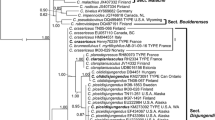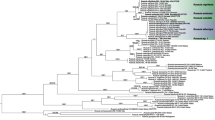Abstract
Fetid Russulas belong to a homogeneous group including species with an unclear taxonomic classification. In particular, the correct interpretation of Russula pectinatoides Peck has remained unresolved, due to the reference collection deposited by C. H. Peck in 1906 consisting of poorly described specimens which were morphologically attributed to at least two different species by subsequent mycologists. Another species considered emblematic is R. praetervisa Sarnari, because it is closely related to R. pectinatoides, from which it was separated on the basis of the morphology of European samples found in Mediterranean habitats. In this paper, we review the interpretation of R. pectinatoides and R. praetervisa according to different authors, and we discuss the taxonomic status of these taxa in the light of molecular analyses carried out on Peck’s reference specimens (n = 3) and 181 samples archived in European and American museums. Sequences of ITS1-5.8S ribosomal RNA-ITS2 regions indicated that R. pectinatoides reference samples deposited by Peck consisted of at least three different species. R. praetervisa was supported as an independent taxon, as it was molecularly distinct from other fetid Russulas. The analysis of museum samples revealed the necessity to describe the species to which in Europe the name R. pectinatoides is commonly applied as a new species, named R. recondita Melera & Ostellari.





Similar content being viewed by others
References
Adamčík S, Carteret X, Buyck B (2013) Type studies on some Russula species described by C. H. Peck. Cryptogam Mycol 34:367–391
Altschul SF, Gish W, Miller W, Myers EW, Lipman DJ (1990) Basic local alignment search tool. J Mol Biol 215:403–410
Avis P (2012) Ectomycorrhizal iconoclasts: the ITS rDNA diversity and nitrophilic tendencies of fetid Russula. Mycologia 104:998–1007
Bonito G, Smith ME, Nowak M, Healy RA, Guevara G, Cázares E, Kinoshita A, Nouhra ER, Domínguez LS, Tedersoo L, Murat C, Wang Y, Moreno BA, Pfister DH, Nara K, Zambonelli A, Trappe JM, Vilgalys R (2013) Historical biogeography and diversification of truffles in the Tuberaceae and their newly identified southern hemisphere sister lineage. PLoS ONE 8(1):e52765. doi:10.1371/journal.pone.0052765
Buyck B, Hofstetter V, Eberhardt U, Verbeken A, Kauff F (2008) Walking the thin line between Russula and Lactarius: the dilemma of Russula subsect. Ochricompactae. Fungal Divers 28:15–40
Dagron C (1989) Nouvelles méthodes d’étude dans le Genre Russula. Bull Soc Mycol Fr 105:259–275
Dentinger BT, Ammirati JF, Both EE, Desjardin DE, Halling RE, Henkel TW, Moreau PA, Nagasawa E, Soytong K, Taylor AF, Watling R, Moncalvo JM, McLaughlin DJ (2010) Molecular phylogenetics of porcini mushrooms (Boletus section Boletus). Mol Phylogenet Evol 57:1276–1292
Dickie IA, Nuñez MA, Pringle A, Lebel T, Tourtellot, Johnston PR (2016) Towards management of invasive ectomycorrhizal fungi. Biol Invasions. doi:10.1007/s10530-016-1243-x
Eberhardt U (2002) Molecular kinship analyses of the agaricoid Russulaceae: correspondence with mycorrhizal anatomy and sporocarp features in the genus Russula. Mycol Prog 1:201–223
Edgar RC (2004) MUSCLE: multiple sequence alignment with high accuracy and high throughput. Nucleic Acids Res 32:1792–1797. doi:10.1093/nar/gkh340
Feng B, Xu J, Wu G, Zeng NK, Li YC, Tolgor B, Kost GW, Yang ZL (2012) DNA Sequence analyses reveal abundant diversity, endemism and evidence for Asian origin of the porcini mushrooms. PLoS ONE 7(5):e37567. doi:10.1371/journal.pone.0037567
Gómez Arenaza M, Monedero Garcìa C (2011) Una nueva especie para la ciencia: Russula ombrophila. Errotari 8:65–70
Hall TA (1999) BioEdit: a user-friendly biological sequence alignment editor and analysis program for Windows 95/98/NT. Nucleic Acids Symp Ser 41:95–98
Kibby G (2005) Fungal portraits. No 24: Russula pectinata and Russula pratervisa. Field Mycol 6:111–112
Leacock PR, Riddell J, Wilson AW, Zhang R, Ning C, Mueller GM (2016) Cantharellus chicagoensis sp. nov. is supported by molecular and morphological analysis as a new yellow chanterelle in midwestern United States. Mycologia 108:765–772. doi:10.3852/15-230
Looney BP, Ryberg M, Hampe F, Sanchez-Garcìa M, Matheny PB (2016) Into and out of the tropics: global diversification patterns in a hyperdiverse clade of ectomycorrhizal fungi. Mol Ecol 25:630–647
McNeill J, Barrie FR, Buck WR, Demoulin V, Greuter W, Hawksworth DL, Herendeen PS, Knapp S, Marhold K, Prado J, Prud’Homme Van Reine WF, Smith GF, Wiersema JH, Turland NJ (2012) International Code of Nomenclature for algae, fungi, and plants (Melbourne Code). Regnum Vegetabile 154. Koeltz Scientific, Königstein
Melzer MV (1924) L’ornementation des spores de Russules. Bull Soc Mycol Fr 40:78–81
Miller SL, Buyck B (2002) Molecular phylogeny of the genus of the genus Russula in Europe with a comparison of modern infrageneric classifications. Mycol Res 106:259–276
Miller SL, Larsson E, Larsson K-H, Verbeken A, Nuytinck J (2006) Perspectives in the new Russulales. Mycologia 98:960–970
Nara K (2006) Ectomycorrhizal networks and seedling establishment during early primary succession. New Phytol 169:169–178
Nei M, Kumar S (2000) Molecular Evolution and Phylogenetics. Oxford University Press, New York
Osmundson TW, Robert VA, Schoch CL, Baker LJ, Smith A, Robich G, Mizzan L, Garbelotto MM (2013) Filling gaps in biodiversity knowledge for macrofungi: contributions and assessment of an herbarium collection DNA barcode sequencing project. PLoS ONE 8(4):e62419. doi:10.1371/journal.pone.0062419
Palmer JM, Lindner DL, Volk TJ (2008) Ectomycorrhizal characterization of an American chestnut (Castanea dentata)-dominated community in Western Wisconsin. Mycorrhiza 19:27–36
Peck CH (1907) New York species of Russula. Bull N Y State Mus Nat Hist 116:43
Pidlich-Aigner H (2014) Bemerkenswerte Russula-Funde aud Ostösterreich 12: seltene und neue Arten der Russula pectinata Gruppe. Österr Z Pilzkunde 23:179–198
Romagnesi H (1950) Une Russule méconnue: Russula pectinatoides Peck. Bull Mensuel Soc Linnéenne Lyon 5:136–137
Romagnesi H (1967) Les Russules d’Europe et d’Afrique du Nord. Bordas, Paris
Sarnari M (1998) Monografia illustrata del genere Russula in Europa. Vol I, Associazione Micologica Bresadola. Fondazione Centro Studi Micologici, Vicenza
Séguy E (1936) Code universel des couleurs 48 planches 720 couleurs. Lechevalier
Shaffer RL (1972) North American Russulas of the subsection Foetentinae. Mycologia 64:1008–1053
Shimono Y, Kato M, Takamatsu S (2004) Molecular phylogeny of Russulaceae (Basidiomycetes; Russulales) inferred from the nucleotide sequences of nuclear large subunit rDNA. Mycoscience 45:303–316
Singer R (1958) New and interesting species of Basidiomycetes. V Sydowia 11:141–374
Singer R (1975) The Agaricales in modern taxonomy. Ed. 3. Cramer, Vaduz
Tamura K, Stecher G, Peterson D, Filipski A, Kumar S (2013) MEGA6: Molecular Evolutionary Genetics Analysis Version 6.0. Mol Biol Evol 30:2725–2729
White TJ, Bruns T, Lee S, Taylor J (1990) Amplification and direct sequencing of fungal ribosomal RNA genes for phylogenetics. In: Innis MA, Gelfand DH, Sninsky JJ, White TJ (eds.) PCR protocols: a guide to methods and applications. Academic, New York pp. 315–322
Acknowledgements
We are grateful to all people and museum curators who kindly provided the specimens of Russula analysed in this study, particularly Felix Hampe (Universiteit Gent, Gent, Belgium); Ursula Eberhardt (Staatliches Museum für Naturkunde, Stuttgart, Germany); H. Marxmüller (München, Germany); G. Lucchini (Gentilino, Switzerland); U. Pera (Viareggio, Italy); M. A. Pérez-de-Gregorio (Girona, Spain); C. Monedero Garcìa (Bilbao, Spain); J. Kleine (Leipzig, Germany); V. Migliozzi (Roma, Italy); University of Michigan Herbarium, Michigan, USA; Cryptogamic Herbarium, The New York Botanical Garden, New York, USA; Natural History Museum, Mycological Herbarium, University of Oslo, Oslo, Norway; ETH Zurich, Zurich, Switzerland; Herbier MPU, Université de Montpellier 2, Institut de Botanique, Montpellier, France; Field Museum of Natural History, Botany Department, Chicago, USA; Fongarium of the Cercle des mycologues de Montréal, Montréal, Canada; Royal Ontario Museum, Department of Natural History, Toronto, Canada; Department of Plant Pathology and University of Florida Herbarium, Gainesville, USA; Department of Ecology and Evolutionary Biology, University of Tennessee, Knoxville, USA (with special thanks to B. P. Looney); Davis and Elkins College Herbarium, Elkins, USA; Ada Hayden Herbarium, Iowa State University, Ames, USA; Royal Botanic Gardens Herbarium, Kew, UK; University of Minnesota Herbarium, Bell Museum of Natural History, St. Paul Minnesota, USA; Mycology Herbarium, New York State Museum, Albany, USA. We also thank Annapaola Caminada and Nadia Ruggeri-Bernardi (Laboratory of applied microbiology, Bellinzona, Switzerland) for their assistance in the molecular analyses and Marie-Louise Chappuis (Université de Genève, Unité de microbiologie, Geneva, Switzerland) for the SEM pictures. We are also grateful to Claudia Abate for her help in the English editing of the manuscript. This research was partially financed by the BNF qualification program, Bern University, Switzerland.
Author information
Authors and Affiliations
Corresponding author
Additional information
Section Editor: Zhu-Liang Yang
Electronic supplementary material
Below is the link to the electronic supplementary material.
Supplementary material 1
(PDF 352 kb)
Rights and permissions
About this article
Cite this article
Melera, S., Ostellari, C., Roemer, N. et al. Analysis of morphological, ecological and molecular characters of Russula pectinatoides Peck and Russula praetervisa Sarnari, with a description of the new taxon Russula recondita Melera & Ostellari. Mycol Progress 16, 117–134 (2017). https://doi.org/10.1007/s11557-016-1256-y
Received:
Revised:
Accepted:
Published:
Issue Date:
DOI: https://doi.org/10.1007/s11557-016-1256-y




